Cycling and Italy '09: Everything is Different
"I must warn you, Giuseppe is in absolutely brilliant condition."
Mauro Mondonico, being both a friend and an Italian gentleman, worries about me when I come to Italy. His words of caution regarding his brother's form were about the truest anyone has ever written. As we ascended the Brianza hills north of Milan I watched Giuseppe Mondonico dance on the pedals and effortlessly lift himself up the road. If I weren't working so hard to keep up he might have been fun to watch.
As we crested one particularly steep hill we passed the gate of a large walled estate. Giuseppe pointed out that it was the home of Fiorenzo Magni, three-times winner of both the Tour of Flanders and the Giro. He must have done very well for himself because it took us a while to get past his property. That was a lot of beautiful, well-tended and probably very expensive real estate.
I still had the suds to climbs these sharp inclines in my 23-tooth cog, but it was a lot harder than it was four years ago. A lot harder. I don't like admitting that there aren't quite as many ponies in the corral now. Time has had its way with me and I hate it.
Four years ago? Yes, it's been four very long years since my last visit to Italy and everything is different. Those years have wrought enormous changes to my life and to the cycling industry in Italy.
When I last was in Italy in the spring of 2005, the twin hammers of a powerful technical revolution and a currency revaluation had about smashed the old order in the Italian cycle industry.
Some perspective. My first trip to Italy was in 1980. Back then, if we could afford it, we rode Italian steel bikes that were built in small shops staffed with skilled artisans. Those craftsmen had often followed a trade pursued by their fathers and sometimes even their grandfathers. The bikes they made were wonderful to look at. The lugs (remember those?), bottom bracket shells and dropouts were etched with the maker's trademark. Even the stem, chainrings, seatposts and derailleurs were lovingly personalized with fantastic detail. The maker's logo would be engraved all over the bike and then painted in with bright colors, usually Italian red, white and green. Produced with intense pride and care, an Italian pro bike of the era was a stunning feast for the eyes.
And the ride? A steel frame from an Italian master's workshop fitted with handbuilt wheels had a feel that made any Sunday rider believe he was part of a great artistic collaboration.
In the 1980s cyclists everywhere rightfully decided that Italian cycling goods were the very best. The world beat a path to Italy, throwing orders at Italian companies that were so big, many firms couldn't fill them. I remember talking to Pogliaghi, the framebuilder, in 1980. I asked him if he could build a few frames for me. He laughed and showed me clipboard with a 4-year backlog of orders.
It seemed that every small town in northern Italy had at least one resident builder. In the area around Venice, called Veneto, it seems that a love of cycling flows through everyone's veins. It felt like whole cities were involved in the bicycle industry. I was told that there were over twenty bike factories and framebuilders in the city of Padua alone. That number might be low because I know there were at least three lug makers in that city.
A trip to the Milan bike show in the 1980s left the visitor gap-jawed, flabbergasted by the sea of small booths. Each stand in the giant show was stocked and manned by one of the hundreds, perhaps thousands of the small workshops scattered throughout northern Italy that were dedicated to the art of the bicycle.
The Milan show is now a shadow of its former self. Some wonder if it will survive. It still seems strange when I remember that only a few years ago the Milan bike show, symbol of Italy's dominant position in the bike industry, was the place to be. It was the show where everyone went to see the newest products of Italian design genius. Fausto Coppi and Marco Pantani, among others, made appearances there. Now, as part of the normal systole and diastole of technology and trade, this great symbol of Italian industry is only a modestly important regional show.
When Ivan Gotti won the Giro d'Italia in 1997 on a Cannondale frame the entire Italian bicycle industry went into shock. The Cannondale frame he rode was both aluminum and American made. By that fall many of the Italian frame makers had responded with their own aluminum frames. But the search for a frame that was both extremely light and reliable had just begun. Very shortly thereafter carbon fiber became the competitive athlete's preferred material.
Unlike France, Italy had been able to compete with the high-quality Japanese bikes and components that became so popular in the 1980s and early '90s. But a new challenge came from China and Taiwan that was different. This time Italy couldn't rise to the occasion. Asian factories had been working overtime and by the time the bike world settled on carbon, Taiwan and China had a large carbon-fiber industrial infrastructure set up. They could produce everything needed, from raw materials to finished goods. That's where the technology and skills to make what the twenty-first century rider wanted resided. The Italian frame and bike companies (with some rare exceptions) chose to buy Asian carbon fiber products and label them as their own production. Desperate, they often insisted that these obviously Asian bikes were made in Italy. Few were fooled. An entire industry found itself obsolescent.
At the same time, one of the first acts of the George W. Bush administration was to devalue the American dollar to make American exports more attractive. That made Italian goods cost Americans far more while Asian products—especially Chinese items priced in the wildly undervalued Renminbi—were amazingly cheap. The quality of Asian high-end bike and frames was so high that even makers like Colnago chose to have some of their bikes made in Taiwan.
The result was the financial equivalent of a neutron bomb. All the buildings were still standing, but the businesses inside were dead.
To cite an example close to home: In 2003 the Mondonicos, whose steel, lugged frames I had been importing into the U.S. since 1983, told me that the declining number of frames they were selling was making their business unsustainable. Because of the reduced value of the dollar against the Euro, I had been forced to raise Mondonico prices several times, resulting in a not-unexpected decline in sales. The carbon revolution had been worldwide and I was about the last active, commercially viable customer the Mondonicos had.
At the end of 2005 they had to give up. The Mondonico family, which had been building frames since 1929, closed its shop.
It wasn't just the cycle industry that died this suffocating death. Many other trades that depended upon carefully honed skills and the tacit knowledge that could be acquired only after decades of work suffered the same fate as framebuilding. Even some famous Italian couturiers ceased having their clothes sewn in Italy, turning to low-labor cost places like North Africa and Eastern Europe.
There are still a few Italian artisan builders left who have all the old skills. They make a few beautiful steel frames for people who care deeply about how their bikes ride. But that thriving, vibrant, exciting world I knew and loved was gone.
Historically, this is an old story. Six hundred years ago Italy was the master of European trade by virtue of its place in the center of the Mediterranean. Then the New World was discovered. Trade moved to the north and Italy's fantastic wealth (in the 1500s the Florentine government had greater income than all of England) became a memory.
My own life changed drastically, in large part because of these same global forces. My wife Carol and I owned Torelli Imports and had built up a thriving pro Italian bike import business. My health collapsed from the stress of dealing with the loss of our primary product supplier, the Italian artisan. In September 2005 I came down with shingles. From then on, while coping with the residual effects of the disease, I struggled to run our business. In 2008 we sold Torelli, our house and everything else we could liquidate and moved to the Ozarks. There, amid the oak-covered hills, riding and running on quiet country roads, I regained my strength.
And so here I was, in Italy for the first time in years, on a bike built and perfectly tuned by the best mechanic and framebuilder I ever knew, Antonio Mondonico.
Thursday, April 16: We had landed the day before, greeted by a cold, wet spring day. We headed over to the Mondonicos. Both Antonio and his wife Gabri look terrific. I can't believe Antonio is closing in on 70. He doesn't look it. The man-tree does well in Italy.
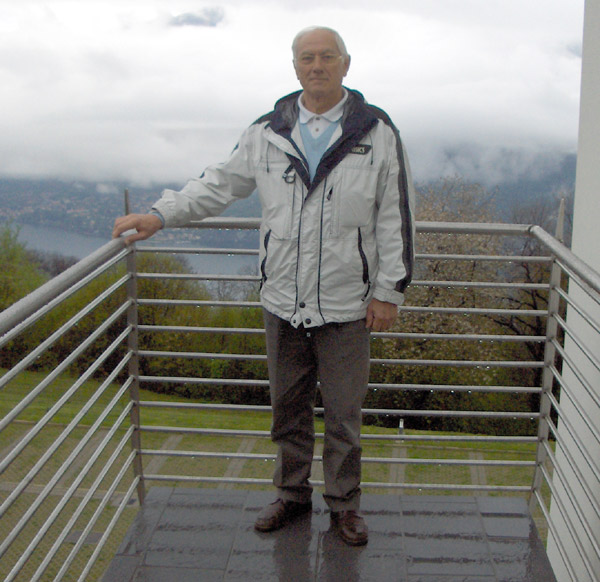 |
||
|
Antonio at the bike museum with Lake Lecco in the background. |
||
Antonio showed me the area in his house that used to be his workshop. All the framebuilding tools had been moved out. In that space where Antonio and Mauro had built thousands of bikes, all that remained was a bike repair stand, a set of cycle tools and the stable of family bikes (where he lets me store my bike as well). Antonio told me that the framebuilding chapter in his life is closed. He was enjoying his well-deserved retirement after a lifetime of very hard work and had no desire to go back to his old life.
I told Antonio that I was working on a history of the Giro d'Italia and needed to go to the new bike museum north of Milan. Since the weather precluded a bike ride, I asked him if he would like to come along with me that very afternoon. Being the kind, agreeable fellow he is, he told me to give him my car keys (his car was in the shop) and he'd take me there.
Sitting between lakes Lecco and Como on the road from Ballagio, perched at the top of the Ghisallo climb there is a church called the Madonna del Ghisallo. For years it had housed bikes, jerseys and all sorts of historical bike racing memorabilia. Now, at the impetus of Fiorenzo Magni, a beautiful new museum next to the church had been opened. Antonio said he hadn't visited it yet and would like to check it out.
The museum, properly situated on Via Gino Bartali, is housed in a spacious modern building and is filled with bikes that used to belong to Bartali, Coppi, Girardengo, Merckx and many more of the great riders of the past.
As we wandered, looking at the various bicycles, one stood out: Giuseppe Saronni's 1982 Goodwood, England world championship bike. The final kilometers of the 1982 race should be memorable for Americans. That was the year Jonathan Boyer took off on a flyer and Greg LeMond, feeling that Boyer had gone too early and would run out of gas, went after him. Saronni went speeding by everyone, easily winning the Rainbow Jersey. LeMond got second and Boyer faded to tenth.
I looked at the bike and somehow it looked different. Finally it dawned on me. It had 650C wheels, which explained the longer head tube that seemed out of place for the short-statured Saronni. Antonio thought I had a few loose marbles and pulled out his trusty measuring tape (I don't think he's ever without it) to see if I was right. He measured the wheels and sure enough, it did have 650s.
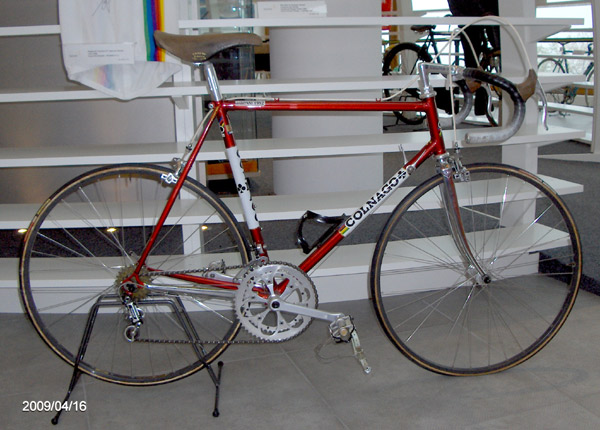 |
||
|
Saronni's Goodwood bike. Note the 6-pin crank. |
||
I bought a stack of books on Italian cycling history, all of them in Italian. I would never get a chance to get my hands on these in the U.S. Clutching my booty we headed back home.
As Antonio drove we reminisced about our careers and all the famous Italian brands that were either no more or had become shadows of their former selves.
Oria, owned by the Mazzuccato family, had made the tubing for many of Miguel Indurain's bikes as well as for hundreds of Torelli frames. Gone.
ITM, the handlebar and stem maker and one of my first suppliers, had shut its doors in 2008. I remember the pleasant surprise that greeted me when I first visited ITM in 1981. The offices were furnished with elegant and expensive-looking modern Italian furniture that gave a striking sense of opulence and taste to the space. ITM was Marco Pantani's bar and stem supplier for the 1998 Tour and Giro. Until his doping disgrace before the penultimate stage in the 1999 Giro, people had gone nuts for anything Pantani used. In 1998 the demand for ITM equipment was white-hot. That moment in the sun wasn't enough to sustain the firm through the current economic storm.
I loved building wheels with Nisi rims. The owner, Gino Nisi, was a likeable, charming man. Beautiful, strong and reliable Nisi rims are no longer made. Sergal jerseys, Sapo pumps; gone. I flipped through my mental Rolodex and Antonio confirmed that so many of the firms that had been an integral part of my business life for decades were no longer around.
So where was Mauro Mondonico?
Mauro couldn't ride with us. After the Mondonico shop was closed he became the sales manager for Columbus tubing. The job's demands are huge and while I was hanging on to Giuseppe's rear wheel Mauro was visiting clients in Belgium.
Friday, April 17: Giuseppe led me over the crest of Magni's hill and we dived down a twisty road barely wide enough for one car. No matter how skinny an Italian road is, there seems to be plenty of room for everyone; bikes and scooters and cars coming and going. I needed this downhill chicane to recover for the next assault on my aerobic system that I knew was coming. It was sunny, but one of those days that was too cool on the way down not to wear a jacket and too hot on the way up to be wearing one.
Giuseppe was a perfect host. Seeing that I had a heart-rate monitor and perhaps concerned that he was riding with a man closing in on sixty, kept asking how many beats my little pump was doing. By the time we got to the stiff, steep stuff I was frolicking in the mid 160s. I think Giuseppe was working a bit, but when I would pull next to him he was riding so easily his bike seemed to be without pedals. Some people are just born to ride a bike.
His bike could have been the centerfold in Bike Eye Candy Monthly. It was, of course, a Mondonico, of the finest Columbus stuff, silver fillet brazed with a carbon rear triangle and fork. He had carbon Mavic wheels, carbon Keo pedals. Every single part was of the highest possible zoot. It was immaculate and fitted him perfectly.
Italians are, first and foremost, lovers of beauty. In Italy it is very important, as they say, to cut a good figure or make an excellent impression. You have to look good. The Italian phrase is "fare una bella figura". Giuseppe, on his rolling artwork, was indeed a bella figura.
When traffic backs up behind a stoplight Italian cyclists pass the cars on the left, often riding on the centerline, seemingly into oncoming cars and trucks. This avoids the congestion that usually occurs when right-turning cars block the road.
I can't get used to it. Giuseppe, like other Italians, did it blithely, nimbly zipping around cars and trucks. The cars accept the practice and let bikes thread their way without the resentment and likely retribution that would surely happen in the U.S. if an American cyclist were dumb enough to try it.
This is the core fact of riding in Italy. The peninsula is crowded and the roads are often inadequate for the number of vehicles that use them. If the roads were to be wide enough to be comfortable by American standards, the entire country would have to be paved. So the natural adaptability that is the hallmark of the Italian mind allows everyone to get where he's going. If a road has only two lanes, often three and sometimes four cars will come to an intersection abreast. They'll take off in what seems complete disorder but they'll quickly fall in line with nary a bent fender.
It's a common occurrence on roads everywhere that a car overtaking a bike rider meets an oncoming car at the same point. In Italy, one of the cars will almost always slow a bit so that all three don't try to squeeze through the same narrow point at the same time. Cars pass cyclists with enough distance to allow a cyclist to feel safe and secure. Giuseppe and I were on very crowded roads as we headed for the Brianza hills, and while I don't love cars and trucks passing me, I never felt threatened or unsafe. That is, unless he led on the left side of slowing cars into what I was sure was certain disaster.
We finished our brisk frisk and gambol through the hills and turned our bikes towards the Mondonico's home. I was feeling fine and let my gentle host know that he could kick it up a notch. Be careful what you ask for. You might get it. That notch was a punishing 25 mph and more over rolling terrain. One overpass after another put me in extremis and forced me to hang on for grim death. Finally I had to let go. Giuseppe slowed to let me latch on. Once I was back in his draft he put it back in the 150-inch gear and recommenced the job of scorching the pavement.
It was only about 40 miles but despite the scourging Giuseppe delivered it was the best ride I'd had in 4 years. It had been well over a year since I had enjoyed the privilege of riding with a skilled and powerful rider. To the best of my knowledge there are no other riders in Sharp, Fulton or Izard Counties in the Ozarks where I live. I'm the only guy with black shorts around here.
While I was out dripping sodium-chloride solution on the roads of Lombardy, my wife Carol was doing real work, trying to fix an unexpected banking problem. Like most modern travelers, we take a minimum of cash with us and depend upon ATMs (Bancomat in Italian; ATM is the Milan mass-transit system) for the cash we need as we go. For some reason, the Bancomats were in a snit and wouldn't fork over the needed filthy lucre. We discovered this on the evening we landed. Figuring that a little talk with some live people would solve the problem, Carol set out to get a cash advance from a teller inside a bank. When confronted with Carol's request, both of the local banks in the little town of Burago di Molgora where we were staying pointed to the Bancomats. Carol explained that the ATMs would not give us any dough and that she needed their help. The employees were helpless. The local branches did not have cash inside. All cash was in the machine.
We figured this was a local problem. Perhaps the smaller branches no longer had sufficient staff to handle cash transactions. We talked to the Mondonicos and they agreed that a trip into Milan, one of the major financial capitals of the world, should surely solve the problem.
We were in for a shock. Italian banks don't have money!!
We tried one after another and they all said the same thing, use the Bancomat. It slowly dawned on me. Italian banks no longer had the citadel look of years past. Italian banks used to have sturdy glass windows and iron cages separating the patrons from the staff, giving the interiors a formidable, fortress-like appearance. Now they are open like a car rental agency. Why not? There's no need for security because there is no cash inside. Now that I was hep to the jive, I noticed that some banks had signs alerting potential robbers that there is no cash inside the bank. Hep though we were, we were still without any cash.
We finally managed to get a cash advance from American Express and even that required jumping through hoops. When we returned home we found that the bank had changed our pin number. We never found out why or when this happened and the bank denies ever changing the number. Was a bank ever at fault?
Normally we have redundant plans to get cash and test everything thoroughly the day before we fly. Over the years we never had any problems and got sloppy. We'll remember this lesson long enough to stay out of trouble for a few months. Now that the horses have left the barn, we've put a good lock on the door.
Saturday, April 18: The next morning was cool and drizzly, leaning to outright rain, not uncommon for spring in Milan. In my dotage I've become a sissy and no longer ride in wet weather. I'll ride on an Arkansas sub-freezing day, but not in the rain. I hate spending hours cleaning my bike after a trip through wet slop. We loaded up the car and headed south for San Marino.
San Marino is a tiny landlocked republic placed entirely within Italy. It's near the Adriatic coast in northern Italy, situated in the region of Le Marche. The San Marinese claim that their micro-state was founded around 300 AD by Saint Marino. Because the enclave was at the top of rugged Mount Titano and the residents were poor, the world mostly left the place alone. They didn't have anything worth taking and getting it would be too much trouble.
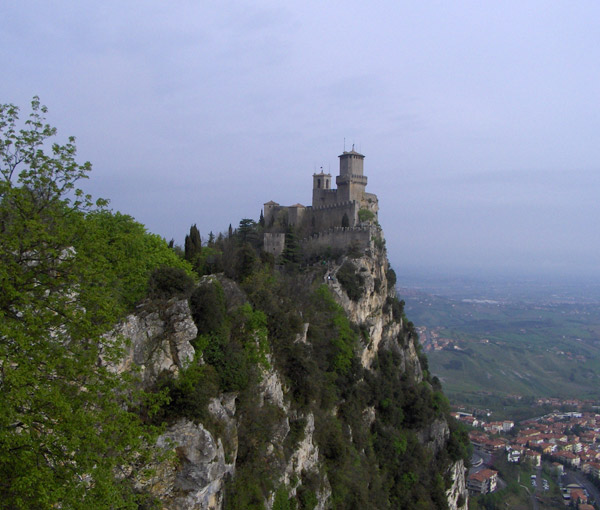 |
||
|
San Marino was a fortified city. Here's a tower placed in a commanding position. |
||
Garibaldi was grateful for help from San Marino during his fight to liberate and unify Italy in the nineteenth century. He let the republic keep its independence. It remains so today, a place where thousands of day-tourists flock to buy vast quantities of kitsch from the endless supply of souvenir shops that line what used to be, I'm sure, charming old streets. The sleek black Audis and Mercedes one sees sporting San Marino plates testify to the soundness of this economic model.
For all of my grousing, the views in almost any direction from almost any place in San Marino are simply spectacular.
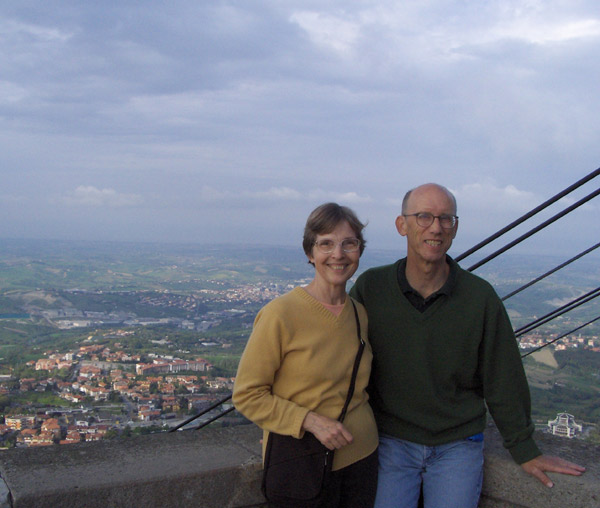 |
||
|
Carol and I take in the view from San Marino. The cables for the funicular are behind us. |
||
Sunday, April 19: My plan to spend the next morning riding in the hills of Le Marche got the big kibosh when I awoke to thick fog and drizzle. Anyone riding in that pea soup risked becoming a Fiat hood ornament, an ambition I have never entertained.
Anywhere else that might be the cause of bitter disappointment. But not here, I was in Italy, after all. Just a few kilometers north is one of the most remarkable places in the world, Ravenna.
Late in the third century the Roman Emperor Diocletian decided that dividing the Roman Empire in half would ease the logistics of ruling a realm under pressure at many points from invading armies as well as the occasional rebellious general who thought he should be emperor. For ease of communication, the capitol of the western half was moved north from Rome to Milan (then called Mediolanum) and then later Ravenna (in 404 AD). The eastern half would be ruled from Nicomedia, near Byzantium. Ravenna, near the Adriatic coast and surrounded by swamps, was very defensible. From this point civilization would try and eventually fail to make a stand.
For a short time in the sixth century, the Eastern Emperor, Justinian, reconquered part of the western empire, including Italy. This was accomplished at a terrible cost in death and destruction. During this war Italy's population probably fell from seven million to a little over two million. Today Italy's agony has been largely forgotten. What we do have to remember the era by are the mosaics in the churches of Ravenna. They are the most brilliant and striking mosaics that have come down to us from antiquity in the western world.
Seeing them requires driving into Ravenna and that is perhaps one of the must difficult tasks I have ever attempted. I write attempted because even in our third visit, I have to say that we failed.
We failed because I am sure that the people who designed traffic flow in the ancient warren of little streets in the town center could not have had foreign visitors in mind. Of course, the streets that barely had enough room for ox-carts and donkeys 1500 years ago must be one-way for cars today. But the result! Each time we came close to the parking lot we were faced with a "do not enter" sign and had to turn away. Sometimes we came within just a few footsteps of our goal. Getting so close and seeing the parking lot less than a stone's throw away kept us trying again and again, like a gambler who knows the next roll of the dice will make him a winner. After almost an hour of this flagellation we gave up and stopped the car at the first legal place and hiked in.
No matter how much trouble we put ourselves through, it was worth it. The sunlight bouncing off the rich gold and blue and red and green tiles simply dazzles. In general, the art of the sixth century is primitive, especially when compared to what Roman and Greek artists had been doing at the end of the second century. Backwards though they may have been, what glorious, magnificent glowing panels they were.
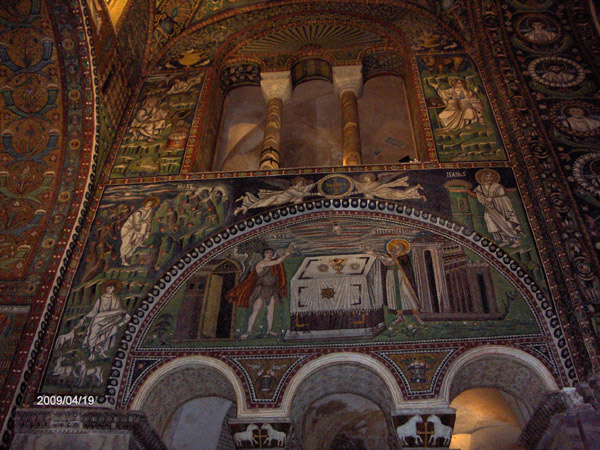 |
||
|
The mosaics were simply dazzling. |
||
Dante, the poet of Inferno fame is buried here. He was born in Florence, and Florence considers him its own. But he's buried in Ravenna because Dante was on the wrong side of a complex seesaw war between the forces of the Pope and those of the Holy Roman Emperor. During the Middle Ages and into the Renaissance, when one of the parties (called Guelphs and Ghibillines) would gain ascendancy over the other, the winner would exile or kill the losers and confiscate their property. At the time of his death, Dante was on the losing side. Ravenna has no plans to return the body of Italy's greatest poet to the Florentines who didn't see fit to allow him to live there when he was alive.
Monday, April 20: The dangerous thick morning fog and wet drizzle again clung to the mountain. So, no riding. But a bike guy can usually find a way to feed his addiction. At the 2007 Interbike show I got to see friend and former Torelli supplier, Mario Vicini of SAB bicycles. I showed him Volume One of our Tour de France history, particularly the chapter describing 1937 and '38' editions of the Tour and one special picture. The picture was of his father, the great Mario Vicini, leading Gino Bartali up the Galibier. Vicini came in second in the '37 Tour. Second place you ask? What greatness is that?
In the 1937 Tour de France Mario Vicini was Touriste-Routier or Individual, the last year that category existed. Vicini rode without a team. He was an independent rider, responsible for his own repairs, lodging, and everything else that a team and its support staff normally does. He had no teammates to shelter him from the wind or chase down breaks. Vicini did it on his own. Furthermore, the winner, Roger Lapébie, clearly cheated with the connivance of the Tour officials. The 1937 Tour was so tainted the Belgian team quit in anger. Vicini was the highest placed independent in Tour history and his namesake son was justifiably proud of his father's accomplishment. When I showed Mario the picture of his father climbing with Gino Bartali he immediately needed a copy. We struck a deal. In exchange for a copy of the book he had to buy me lunch in San Marino next time I came over to see him.
Unfortunately our schedule required a morning visit and departure. Mario wasn't going to be forced to feed us this time. I did tell him about my Giro history project and asked him about any materials involving Giro history he might have. He put his library of cycling books at my disposal. Thanks, Mario. I also asked him if he would be so kind as to scan some of the terrific photographs he has of his father racing in the 1930s. I love that era of iron men on wooden rims riding on dirt roads. He said he would. Look for them on our home page "Picture of the Week".
We chatted a while. Indicative of the ongoing weakness of Italian products in the American cycling market, Mario told me that it no longer paid for him to visit American trade shows. Sadder, he told me that many of the biggest names in Italian cycle production were no longer even showing in the Milan show, preferring to display only at the German Eurobike.
Before leaving I took a chance to do a little wandering in Mario's SAB warehouse. He has so much stuff! Spokes, wheels, bars, stems, Campagnolo and Shimano parts are stacked high and bicycles and frames are everywhere. I strolled up and down his aisles stupefied by all the equipment. But, Hadrian calls. We said our goodbyes and hit the Autostrada (Italian freeway) for Tivoli, east of Rome.
Hadrian was Roman Emperor during what the historian Edward Gibbon calls the pinnacle of Roman power and prestige, the second century. Gibbon goes so far as to write that the second century, ruled by men who chose their successors and adopted them rather than depend upon usual the genetic lottery of dynastic succession, might be the time of greatest felicity in the history of the western world. Gibbon made this judgment in the late eighteenth century. I leave it to the reader to decide if the world has really improved since then.
Hadrian himself was well traveled, refusing to sit still, relentlessly touring and inspecting his principate. His fine mind was educated by the best thinkers of his time. When it came time for this strangely unpopular man who had so ably ruled the world to build himself a palace, he chose a site away from Rome. There, for years he built palaces, pools and gardens. We're told that Hadrian did a lot of the design work himself. It's all very, very beautiful. Yet it is not without the feel that as ideas stuck Hadrian, he just added a building or garden here or there. In ways, it's like a Winchester House built by the king of the world. Unlike the Greeks, the Romans were not obsessed with symmetry, so the rambling layout is unsurprising. In his final years Hadrian became a bitter misanthrope. Perhaps that's what being king of the world does to you.
The buildings are quite ruined, but there is still a lot is left for the tourist to see. Not enough to give an explicit picture of the luxury and beauty Hadrian created, but enough to give one's imagination something to work with. That is the real art and joy of ruins, using the few bricks and stones that the miserly centuries have left us to enable one's own brain to recreate a world that is no more.
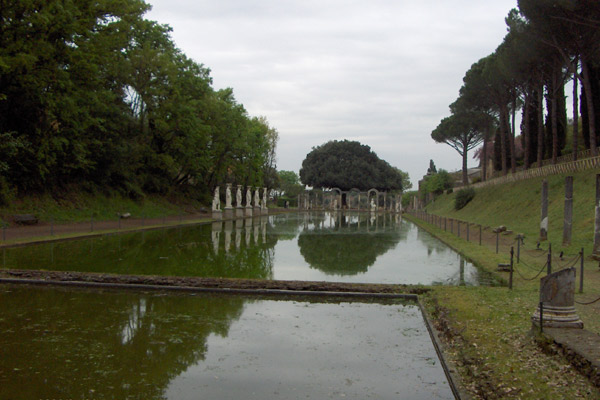 |
||
|
It doesn't take much imagination to see that at one time this was a place of extraordinary beauty. |
||
The light drizzle followed us south from San Marino, so after the departure of a busload of schoolchildren we had this magnificent place largely to ourselves. Hadrian's Villa is huge, having a circumference of about 7 miles. We spent hours wandering amid the brick remains and still there we left far more of the villa unexplored because it was unavailable to tourists.
We spent the night in a curious hotel right next to the villa. In recent years every Italian hotel we have stayed in was up to date with electronic security doors, refurbished rooms and tidy, modern furnishings. This wasn't true when we first started traveling to Italy in the early 1980s. The Italian economic miracle took a while to percolate into every small town lodging house. But here we were, in a hotel with old skeleton keys to doors that surely kept out no determined thief, distressed old floor tiles and worn oriental rugs, the hallmarks of old hotels in a Western Europe that has largely been replaced. It brought back memories of pensions that cost $15.00 a night, and that included breakfast. But this hotel was $130.00. I'm sure that its location right next to one of the greatest archeological sites in the world let them get away with it. Carol and I took it like men.
The modern city of Tivoli, is another one of those charming places in Italy that were probably once delightful to visit. It would be today but for the invention of the automobile. Everyone hurries to and fro with nary a place available to park or stop. Every square inch along the city's roads is crammed with cars parked in ways that redound to their owners' parking skills. Slow or stop and the car behind, which is following so closely you can't see his lights, lets loose with an angry toot from his horn.
I have to stop here for a moment. We all get lost when we travel. Sometimes you come to a fork in the road and you have no idea which way to go. Our solution is to stop at any moment of indecision. If we come to a fork and don't know whether to go right or left, I park the car at the point of the fork, allowing plenty of room for cars to pass me in either direction. As I noted earlier, when one drives slowly in Italy, the car following will be millimeters behind. This means that when I stop at the fork apex, the car behind comes with me and is forced to stop with me. So there we are, both parked on the road, nose to tail. Worse than anything, he looks bad. He does not fare una bella figura. He is una brutta figura. His response, since I got him in the stupid mess and I'm the moron, is to honk his horn. With that aural encouragement he is sure I can make a decision and we can both continue on our ways. Then he won't have to back up and re-enter traffic.
Honest. I'm just sitting there in my car, parked, with cars passing on either side with a car stopped right behind me, honking away. It's happened several times.
But, I digress. Tivoli has an abundance of riches including one of the most beautiful gardens in the world, the Villa d'Este, largely built in the mid to late 1500s by Cardinal Ippolito d'Este. I used to think that Butchart Gardens in Vancouver, Canada was the most beautiful man-made place I had ever seen. Perhaps it still is, but it has competition here in Tivoli. The garden's architect took advantage of the steep hillside the villa is built upon and used the pressure of the water flowing downhill to create a spectacular series of fountains. Everywhere the happy wanderer turns there is a gentle spray of water or a giant cascade flowing around a statue. It must have been a cool and welcome retreat for the cardinal during the blistering Roman summer.
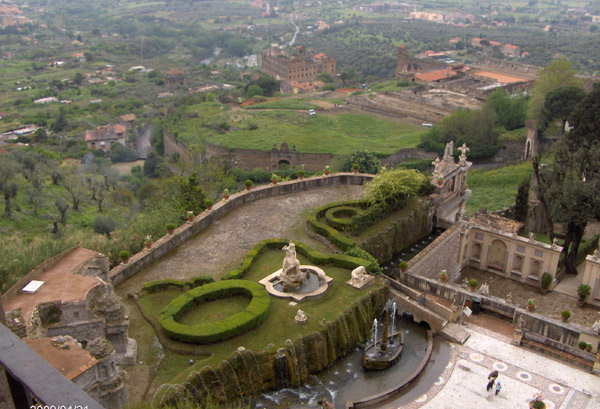 |
|||
|
You can get a sense of how steep the hillside is that the gardens were built on. |
|||
 |
|||
|
Fountains were everywhere. |
|||
Having taken a quiet morning to enjoy one of the most civilized and delightful places on earth, it was time to head to Naples. Which, while it does have its delights, is definitely not one of the most civilized places on Earth. Not by a long shot.
For centuries people have come to this area with its incomparable hillside views of the Gulf of Naples, Mount Vesuvius, and the island of Capri. Just a bit further south, there is the magnificent Amalfi Coast. Since before Roman times when the Greeks, in the words of Herodotus, squatted around the Mediterranean like frogs, people have found this one of the choice places to live. Pliny the Younger wrote about his villa here. Goethe came and was enchanted.
For all of its good geographic fortune, Naples and all of southern Italy has suffered. The Normans conquered and feudalized the entire south. Northern Italy was never truly feudalized and in that happy accident of history lays a lot of the miracle of the Renaissance. The Angevins of France followed the Normans, and then the Spanish ruled it for centuries. Italian historians say that the Spanish reign, using the feudal systems already in place, exacerbated the poverty of the south, causing a terrible concentration of wealth at the very top and crushing poverty at the bottom. The twentieth-century transformation of Italy into the wealthy agricultural and manufacturing powerhouse it is largely passed the south by. The results of hundreds of years of exploitative rule are not so easily reversed.
Misrule in the modern era has not improved the lot of the Neapolitans. After the war Naples, which used to have a good mass-transit system, was abandoned to the automobile. Given the city's incredible population density, tearing up the city's rails was a calamity that almost mimics the removal of the trolley rails in Los Angeles. Almost. I believe the Neapolitan failure was passive. The loss of Los Angeles' 1,500 miles of track with their irreplaceable rights of way was no accident. It was a well-documented, deliberate crime committed by the American automobile and petroleum industries designed to increase car and gasoline sales.
Therefore one can't smugly criticize Naples when, perhaps for different reasons, we've made some of the same mistakes. In Naples the effect is tragic. There were complaints about overcrowding in Naples in the seventeenth century and it's many times worse now.
Veterans of Naples' traffic had warned me that it was difficult. I had an intellectual understanding of what driving in Naples entailed but I was truly entirely unprepared for the noisy chaotic reality that awaited us.
We had come south to visit good buddy Valeria Paoletti. Actually the highly published Dr. Valeria Paoletti of the University of Naples who has also done several of the oral history interviews on this site. Besides Valeria, awaiting us in Naples was one of the finest antiquities museums in the world, the island of Capri and the Amalfi coast as well. There was much more, but we had only 3 days.
Valeria was so concerned about our driving in Naples that she insisted we drive to her university, just off the Autostrada, from where she would lead us to our hotel. I asked her to go slowly because I was driving a rented diesel Opel with the idle set too low. The accelerator had a frustrating lag and a quick start was difficult.
"Sure", Valeria said. She understood my situation.
Sit down, shut up and hang on…. We were off. Now that I've ridden in a car driven by Valeria I now know that on that day she was driving with what was for her, extraordinary restraint. But to me, a guy from dull Arkansas (or a dull guy from Arkansas) it was a high-speed, white-knuckle ride. We threaded our way past trucks and cars, all seemingly intent on getting where they are going yesterday. Why every car in Naples isn't a smashed-up dented hulk is a mystery. Besides the rampaging Fiats and Iveco trucks, one has to keep an eagle eye for the millions of dodging and weaving scooters and motorcycles. They blitz the streets at suicidal speeds. It has been written that the scooters treat the sidewalks of Naples as if they were the fast lane. This is not true. The sidewalks are too cluttered with the occasional Fiat 600 whose owner didn't have the courage to properly double or triple park in the street and Africans selling Chinese knockoff sunglasses. The gas-powered two-wheelers feel they own the road, and by God, they do.
Tuesday, April 22: We planned to do nothing more in Naples the first day than walk around, absorbing the sights, sounds and smells of the city and then hit the national museum. For many months Naples had been oppressed by a garbage collectors' strike. A little before we arrived the strike had been settled and the mountains of trash had been collected. The made the "smells" part of the day a lot better.
Our hotel was up on the Posillipo hill looking down on the docks and across the bay to Vesuvius. It was lovely and well out of the crazy city center. We just put on our sneakers and walked to the funicular tram that ran up and down the hill. It deposited us on the seafront. We spent hours wandering up and down the streets of Naples. It was a sunny morning that allowed us to visit castles and ancient churches as well as crowded narrow streets packed with shoppers.
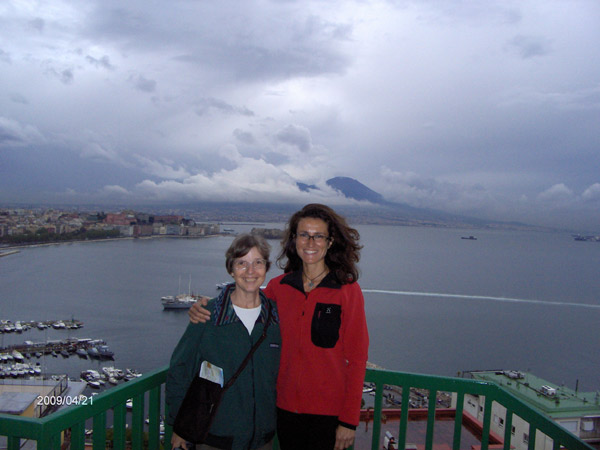 |
||
|
Carol and Val improve the view from the Posillipo hill across the Bay of Naples to Vesuvius. Vesuvius is the hulking bulk just peeking out from the clouds. |
||
Everyone, locals included, warned us to carry nothing of value into the city because thieves were everywhere in Naples. We brought nothing more than a little cash. We never felt threatened, but pickpockets aren't scary. They're quiet and unobtrusive.
Naples was the birthplace of the pizza. Neapolitans maintain that pizza cooked there is better than anywhere else in the world and they might very well be right. Valeria sent us to a famous 70-year old pizza joint, Pizzeria Matteo, in the student area. It was a bare bones, crazy, crowded little place but Val was right. The pizza was heavenly and left us fortified for our main goal of the day, the National Archeological museum.
For many tourists, the museum is their only stop in Naples and it should not be missed. The finest items that have been unearthed at Pompeii and Herculaneum have been deposited here. I had no idea how fine the collection here really is.
Virtually all statues, mosaics, painting and bronzes that have come down to us from antiquity are in some state of ruin. Large bronzes in any condition are very rare because most have been melted down into cannon or some other weaponry. Marble statues lose their noses, fingers, arms and legs. Mosaics and paintings get damaged. Like ancient buildings, many old artworks require an imaginative fill-in.
Not here. Walk into the National Archeological Museum and the first things you see are bronze and marble statues that look like they had just come from the artist's workshop. There are a couple of paintings that look so fresh they could have been painted yesterday. I just stood in front of this display, amazed. Preserved for centuries in the ashes of Vesuvius, their perfection startles the unwary viewer. Wait, there's more. The museum also houses the Farnese art collection with several magnificent and renowned sculptures, including the Farnese Hercules, an over-muscled, thick-waisted statue with a weirdly small head. The greater piece is the Farnese Bull, a complex sculpture of men wrestling a bull, entirely carved from a single block of marble.
Thursday, April 23: The island of Capri lies just off the coast the coast of Naples. A high-speed ferry leaves hourly from the port of Naples. I thought we had arrived fairly early but boats had been dropping off tourists for hours and it showed. We were unprepared for the mass of humanity crowding the little island. The weather was threatening rain so we decided to take in the famous Blue Grotto first thing.
The Blue Grotto is a beautiful excuse for extracting the maximum possible money from tourists with the maximum hassle. First, one buys a boat ticket to grotto entrance. That trip is done in a small boat that carries, maybe, 10 or 12 people. That was 11.00 euros ($15.00 at the time) each. I pulled out my credit card at the ticket building.
"Cash!"
Reluctantly, I reached into our dwindling stash and plunked down the bills. The trip along the tall, sharp cliffs was beautiful. Carol noticed the clear, blue-tinted transparent water that surrounded the island. I admit it, $30.00 was cheap for such a lovely cruise.
When we arrived at the grotto we were greeted by a strange system. Rowboats that could carry four passengers each would come up to our boat. We were then rowed over to another larger boat where we reached up and paid another 10.50 euros each for the trip into the grotto itself. Why this couldn't be included in the first ticket, I'll never know.
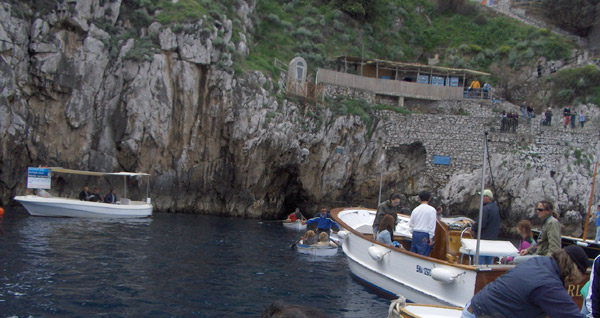 |
||
|
At the entrance to the grotto. A rowboat (with someone in red) is about to go in. The boat on the left is the vendor selling tickets to go in. |
||
Then the gondolier paddled us over to the small entrance to the grotto. He had us put our legs under the seats so that we were lying down. We were absolutely locked in this way and if the rowboat had capsized, we would have drowned. I always imagine that the hotel I'm in will burn down or the plane I'm flying in will fall out of the sky, so fantasizing about a simple rowboat overturning is normal and usual for me. I am convinced that certain death follows my every step.
Locked into our rowboat with our gondolier reminding us every minute how vital it is that we give him a five or ten euro tip, we headed for the small hole in the cliff. We flattened ourselves further while the gondolier grabbed a chain that hung from the top of the opening. Timing the rising and falling surges of the sea he gave a great yank on the chain and whoomp! We were in the dark cave along with five or six other rowboats. Now our gondolier gave us a rest from being reminded of our obligation to help put his kids through college and began singing. The begging might have been better.
Our eyes became adjusted to the dark. The sight of the water's eerie blue light that refracted up from the ocean through the opening in the grotto was one I won't forget. I could appreciate why thousands of people each day come here. It is one of those spectacular and unique sights that for all the crowds of tourists and pesky locals working the visitors for maximum profit, really repaid the effort.
The rest of the day was spent wandering along the beautiful walks of the island and eating twelve-dollar sandwiches. It was spring and a million blossoms perfumed the air. It was delightful.
As the ferry took us back to Naples it started to rain and rain hard. We ran to the crowded bus stop at an island in the middle of the street and took in the situation. Traffic had almost completely stopped. Our fellow soggy travelers informed us that this was normal. When it rained in Naples, traffic ground to a complete halt. To make things worse, Neapolitans have a hair-trigger horn response. At the slightest impediment to his progress or any other reason that comes to mind, a Neapolitan's first impulse is to honk his horn. In the rain the blaring horns were loud and continuous.
Finally the bus made it. After the long wait the bus was already horribly crowded. The passengers from our stop forced their way in. They were not going to wait another hour for the next one. Our bus was a moist, hot, packed can where movement was almost impossible. I'm sure riding a bus in downtown Naples in the rain is in Dante's fifth circle of Hell. It's all part of the romance of the road.
Friday, April 24: Valeria invited us to a big lunch at her parents in Salerno, south of Naples. Mr. Paoletti is a great cook and a generous host. He served us a fabulous Italian meal with pasta, vegetable pie, different cheeses (including the special fresh buffalo mozzarella that can only be bought here), lots of wine and sweets. I can't remember all the delicious things that Signor Paoletti put on the table. He topped it off with his own homemade ice-cold limoncello. I came close to suffering a death by food.
Then it was time for coffee.
Valeria and I agree on almost everything. The big, serious bone of contention between us is cappuccino. To an Italian, the espresso shot mixed with warm, frothy milk is a morning beverage and only that. Valeria holds that having a cappuccino after 11am is an extreme violation of good taste. Not as bad as putting cheese on seafood pasta, perhaps, but still something that is never to be done. Ever.
Like many tourists to Italy, I don't particularly like espresso and when I'm in Italy I like to drink cappuccino any time I want a coffee. Valeria wasnt going to have this perfect afternoon spoiled by my performing the unnatural act of drinking a cappuccino. This is important to her and to almost all Italians. She suggested a compromise that wouldn't harm the natural order of the universe, an espresso macchiato, an espresso with a tiny amount of hot milk. I gave it a try. It still had the bitter espresso flavor many love and I dislike.
After hours of conspicuous consumption Valeria managed to get us upright and walking to her car. She wanted to take a drive on the Amalfi road to the little city of Ravello, perched way up on a hill overlooking the cliffs and the Tyrrhenian Sea. The Amalfi Road is a narrow passage hacked out of the limestone cliffs that lie along the coast between Salerno and Sorrento. The little villages along the way are sometimes built at sea level and sometimes they cling to the side of the hill, hundreds of feet above the water. The Amalfi Road rises and descends as it hugs the cliffs. Each corner yields a breathtaking view of either a beautiful ancient town or of a vista of the cliffs and the clear sea. Every inch of the road is fabulous. Sometimes professional bike races use the road and competition can stop as the riders slow to enjoy the view.
Valeria is too much of an Italian to drive the coast at a leisurely pace. She skillfully hurled her car through the corners. The fragile-looking railings, beyond which there was nothing but air above a long drop to the sea, had many scars, showing that ours wasn't the only vehicle that thought of the Amalfi Road as an attractive slot-car track. We (to my American sensibilities) roared through the little towns, furious at the slower-moving cars that could not be driven by any right-thinking Italian.
"Tourists, probably Danes. There are a lot of them here," she said.
Valeria squeezed her red-shifting Nissan past the oncoming cars and buses. I'm sure at least two pieces of paper would fit between the car doors and the side of the road. Maybe three.
Our goals in Ravello were two old villas with gardens that look down the steep cliffs. They were worth the entire trip. I'm a clod with words so there is no way for me to describe the incomparable panoramas we enjoyed that day. That is a job for poets. Let it suffice to say that my life is richer for Valeria's having brought us to Ravello that day.
We stopped at a small village for a snack. I decided to push the envelope. While Carol and Val ordered espresso, I asked for a cappuccino.
"That's OK", the waiter said to Val, as if speaking about the mentally deficient, "we get lots of tourists here."
And of course, the trip back was also done at the same vertiginous speed, grousing at any (surely) foreign drivers ruining the pleasure of tempting fate by testing the adhesive qualities of Italian car tires.
We didn't fall into the sea or crash into an oncoming bus, though I was sure that at any moment that was going to be our fate. We reluctantly parted with our lovely hostess, troubled by fact that we would shortly we would be six thousand miles apart.
And that was the real end of the trip. We had to drive back to Milan and return the very well traveled but mostly unridden bike to its place of repose, the Casa Mondonico. Giuseppe was there to help us put things away. Giuseppe, who had trained to be a concert pianist, asked if I would like him to play anything for us. Would we like a private concert? My goodness, yes.
The vacation was over. As we left Giuseppe asked me when we were coming back.
Not soon enough.








